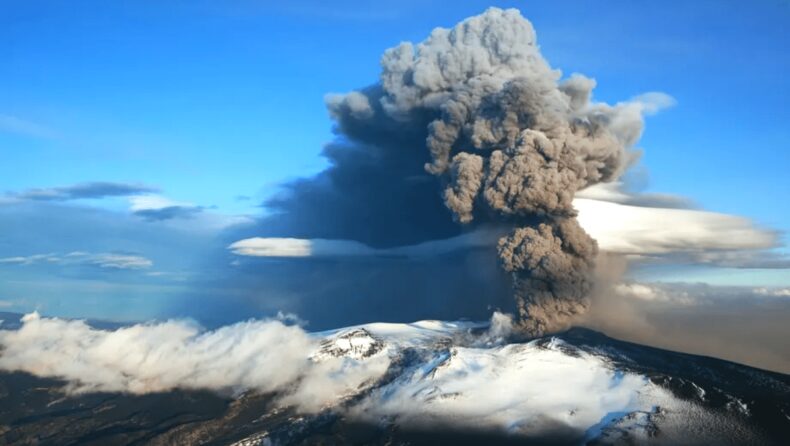A new study reveals that volcanic eruptions may release at least three times more sulphur than suggested by the current climate models.
This University of Washington-led research can help improve our understanding of the Earth’s atmosphere and its connection to air quality and climate.

Highlights
It has been discovered from a Greenland ice core that volcanoes discharge three times more sulphur into the Arctic atmosphere than currently estimated by climate models.
The research was sponsored by the US National Science Foundation, NASA, and the National Natural Science Foundation of China.
Sulphate aerosols released during passive degassing are much higher than those released during eruptions over longer timescales, according to the research.

The amount of sulphur released into the atmosphere by passive degassing is at least 10 times greater than that released by eruptions, and it could be as much as 30 times greater, explained Ursula Jongebloed, a study first author and doctoral student of atmospheric sciences at the University of Washington.
Sulphate aerosol levels between 1200 and 1850 were determined in an ice core from central Greenland by the global team of researchers.
The scientists were intrigued by the sulphur emitted from marine phytoplankton, which was primarily credited as the key source of atmospheric sulphate in pre-industrial times.
Key Points
- Sulfur isotopes in a Greenland ice core show that passive volcanic degassing contributes 66% of preindustrial Arctic sulfate
- The volcanic inventory used by most climate models underestimates passive degassing, possibly due to missing hydrogen sulfide emissions
- Elevated preindustrial passive volcanic degassing reduces the estimated cooling effect of anthropogenic sulfate in the Arctic
Becky Alexander, a study senior author and professor of atmospheric sciences at the University of Washington, explained that our knowledge of the natural, pristine atmosphere in terms of aerosols is limited. Our understanding of how humans have affected our atmosphere begins with realizing that.
Researchers intentionally avoided major volcanic eruptions and focused on the pre-industrial era, when it was easier to distinguish between volcanic and marine sources.
Jongebloed explained that the plan was to calculate the amount of sulfate coming out of volcanoes, subtract it, and move on to studying marine phytoplankton. However, when she first calculated the amount from volcanoes, the team decided it needed to be addressed.

Ice cores within the Greenland Ice Sheet document emissions from North America, Europe, and the surrounding oceans. Despite the fact that this result is limited to geologic sources in that region, which include Iceland’s volcanoes, the authors expect that it can also be applied to other areas of the world.
Jongebloed adds that, according to the results of their research, volcanic activity is twice as important as marine phytoplankton even without major eruptions.
Researchers found that non-erupting volcanoes leak sulphur three times more than initially thought, which can provide crucial data for predicting past, present, and future climates.
Several types of aerosol particles block solar energy, including those from volcanoes, vehicle tailpipes, and factory chimneys.

Due to higher natural aerosol levels, human emissions, now less of a factor in climate change than they once were, such as acid rain in the 1970s and increasingly stringent air quality standards resulting from the Clean Air Act and other measures to reduce air pollution, which have less effect on temperatures than previously thought.
As sulphate aerosols build up, their effect decreases. In other words, the more sulphates you have, the less effect they have. As volcanic emissions increase, sulphate aerosols increase as well, which reduces the effects man-made aerosols have on the climate by a factor of two to five, explained Jongebloed.
This indicates that the recent Arctic warming has exposed the full effects of increasing heat-trapping greenhouse gases, which are by far the most important controlling factors.
It’s not good news or bad news for the climate.” “But if we want to understand how much the climate will warm in the future, it helps to have better estimates for aerosols.
Ursula Jongebloed
Global climate models can be greatly enhanced by better aerosol estimates.
“We believe the missing emissions from volcanoes are caused by hydrogen sulphide,” Alexander said in reference to sulphur gas. A better way to estimate volcanic emissions is to consider hydrogen sulphide emissions,” he added.
Volcanic eruptions
Volcanic eruptions release gases and dust particles into the atmosphere, which impact the climate.
A large amount of greenhouse gases have also been released into the atmosphere by volcanoes during periods of extremely high volcanism millions of years ago.
Due to air circulation patterns in both hemispheres, volcanic eruptions in the tropics are likely to affect climates in both hemispheres because gases, dust, and ash enter the atmosphere.

There has not been a volcanic eruption as large as the one on January 15, 2022, at the Hunga-Tonga-Hunga-Ha’apai volcano since Krakatoa erupted in 1883.
Recently the Chilean authorities have issued an ‘orange alert’ due to increasing seismic activities in the regions of Lascar volcano.
The Lascar volcano in Chile is part of the Central Volcanic Zone of the Andes, a volcanic arc that extends across Peru, Bolivia, Argentina, and Chile. It is the region’s most active volcano, with eruption records dating back to 1848.













